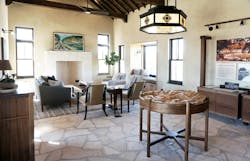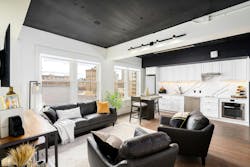CREO’s Ann Hampton on Leveraging Local Craft and Culture in Interior Design
San Antonio, Texas may be known for its dense military base population, but it also offers a number of engaging cultural and hospitality venues. From artisan neighborhoods to historic and architecturally significant sites, galleries, museums, and a plethora of upscale hotels and restaurants along the San Antonio River Walk, there is plenty to engage the senses and inspire the soul.
A San Antonio native, interior designer Ann Hampton resettled in the area after spending several years building her hospitality design portfolio in New York City and consulting across other regional projects. When her husband retired from the military, they relocated to San Antonio, where Hampton joined CREO Architecture. Hampton recently spoke to i+s about how the blend of Spanish, Mexican, Tejano, and German influences and the local artisanal talent pool helps the CREO team create a unique yet authentic story for every project.
i+s: Can you give us a little bit of background on your experience and also on the CREO Architecture firm ethos?
Ann Hampton: I started my career about 23 years ago. I graduated from Texas Tech University and immediately moved to New York City, where I got involved in hospitality interior design, and I just loved it. Even though I studied architecture, the interior just really spoke to me.
I was there for about six years, and then I married my husband while I was in New York. I did high-end, luxury hotels, restaurants—I mainly focused on hospitality—and my husband is in the military. So after that, I consulted all over the place. Then we just finally retired in San Antonio. Not surprisingly, it’s “Military City, USA,” and we’re from San Antonio ourselves, so that was great for us, and that’s where I met up with CREO.
CREO is a small firm; we have 10 or less employees. We have two offices, one in South Carolina and one in Texas. What we’re really good at is that every team member has a voice. There is a staffing hierarchy, but it’s not so [rigid] that someone who’s new doesn’t get to speak on a project. So we really have a varied voice—people who have been in the industry for 20 years and people who’ve been in it for one or two. Every voice matters.
Personally, coming from my hospitality background, I view every project as hospitality. Every project should be about user experience and trying to be thoughtful in every detail so that your guest experience, your user experience, your operator experience is all enhanced by your design.
I think the narrative of a project is important as well as design—all those functions and operations that have to happen. If you’re in an office or a hotel or even a residence, it should be intuitive and authentic. You shouldn’t have to think, “What’s going on here?”
i+s: Let’s talk about San Antonio. It’s an area full of history and a blend of influences, right? How would you describe the local character of the city?
Hampton: As a local, I see it a little differently than as a tourist. We’re in a diverse area. There were Six Flags of Texas. The theme park—it’s not called that for no reason! We’ve had Spanish influence, Mexican…we’ve been a country at one point, and [there has been] a lot of German influence. Tie that into now, and it’s one of the biggest military capitals of the world. With tourism and the military, there are so many people coming in and going out.
Obviously, when you think of San Antonio, you think of the Mexican and Tejano influence. But I live on the north side of San Antonio, closer to New Braunfels. So I feel the German influence up there as well.
i+s: How do you weave that culture and history into your design approach in a thoughtful way? And how do you balance those unique elements with the need for design that can stand up to time?
Hampton: The first way to do it is probably exactly the opposite of what we were talking about offline, with the Mexican food restaurants in your area looking the same. There’s definitely a stereotype. Stereotypes are a thing for a reason. They do pull from culture, but sometimes in a more ostentatious kind of way, like with sombreros and bright colors. A good way to do it is to just pare it down and try to work with your owner or your operator and find out what story they’re trying to tell about their specific space or restaurant, whatever it might be. Home in on how to be authentic to that vision.
I do this a lot with art. I try to reach out to local artisans. For instance, if you’re designing a restaurant project, it might be hard to have a local artisan make every plate for your restaurant, but maybe you can have them create a handful of designs that you take somewhere and have them produced [in quantity]. You have that authentic feel, but more on the scale that is appropriate. Also look to the art on the walls. We do a lot of murals in my office. So we do reach out to local artists to see if they want to create something in the space.
Another important aspect of working with artists is that you let them have a voice in the project. You went to them because they are a local artist. So even though you have a vision as a designer, and maybe the owner has a vision of what they’re looking for, the artist has an equally important vision. You want that story to be told. I try to give some parameters and see what they come up with. I would say nine times out of ten, we’re just floored when we let them have creative license.
i+s: Can you give an example of how their work has been significant to projects?
Hampton: One that comes to mind because it’s so recent: We did a nonprofit project here in San Antonio. This is not a hospitality project; it’s more of a retail unit called Assistance League. They serve kids in need who get to go shopping for their own clothes. A volunteer guides them through the process. It’s really fun for them, and heartwarming, because maybe this is the only time they’ve gone shopping for their own clothes. We had a local artist come in and do a whole mural—very San Antonio inspired—on the outside of the building, highlighting kids of all cultures. [It’s] everything you could possibly think of when you want to make a kid feel welcome.
In going that extra mile to find a local artist to do something that speaks to that project, everybody involved was wowed by it. The kids love [the mural], and it has enhanced the project so much more than if we had just gone online, had something printed, and had someone come and roll [it] on the wall. It is that next-level experience that makes it so much better.
i+s: We also learned that CREO likes to work with historic buildings in terms of adaptive reuse projects. How do you merge contemporary functionality and style while respecting the legacy of a building?
Hampton: Yes, sometimes without even wanting to [balance those things], you need to because of historic tax credits the client might be trying to get. Or it’s a registered building, so there already are a lot of guidelines that you have to follow. Of course, when we are removing the stuff that’s not historically significant and you unearth beautiful, tiled floor, or you see cast iron columns—whatever you might find—it’s always great to incorporate that into the design. How you’re detailing your new materials next to the older materials is very important for the project—as a whole to get those tax credits, as well as to make it an authentic project.
Again, through interiors there’s a lot of ways I do that: with interior furnishings and again with art, and lighting…some of those historic finishes can be great to light. They provide textures and a drama that you might not get with a normal sheetrock wall. You have to approach every project with a new eye so that you don’t get caught up in how you did it last time. You have to think, “What does this project need and how do I accomplish the goals of this project in a unique way?”
i+s: That’s so compelling, because one of the things that I’ve often wondered since I started working with i+s is how designers find their own style and their aesthetic…that also works with the idea of accomplishing the customer’s vision.
Hampton: That’s a challenge sometimes! I joke all the time that I love and I hate HGTV because everybody has a very strong design language now. There are a lot of times when clients have a very strong idea of what a project needs to be. It’s our job as design experts to listen to [the] client and understand what they want.
Take your design sensibility, please, because you’re working on the design, too. So obviously you want to be very happy with that at the end of it; you don’t want to let someone else push the pencil around the paper for you.
A lot of times it’s just knowing your own design identity and then having some humility in that. So when a client comes to you with a very strong idea, you’re not immediately like, “I’m the designer here; I will figure it out.” Every project is a collaboration on all ends, whether it’s with a consultant, an artist, an owner… And so I think it’s just having that humility as a designer—even if you have a very strong aesthetic—to be able collaborate with the entire team to come up with a unique vision for that project.
*Interview has been edited for clarity and length.
About the Author
Carrie Meadows
Editor-in-Chief
Carrie Meadows is Editor-in-Chief of interiors+sources (i+s), where she leads editorial strategy, content development, and brand storytelling focused on the people, projects, and innovations shaping the design industry. With more than two decades of experience in B2B media, she has built a career connecting technical expertise with creative insight—translating complex topics into meaningful stories for professional audiences. Before joining i+s in 2024, Carrie served as Editor-in-Chief of LEDs Magazine within Endeavor Business Media’s Digital Infrastructure & Lighting Group, guiding coverage of emerging lighting technologies, sustainability, and human-centric design. Her earlier editorial experience spans across Laser Focus World, Vision Systems Design, Lightwave, and CleanRooms, where she managed print and digital publications serving the optics, photonics, and semiconductor sectors.
An advocate for clear communication and thoughtful storytelling, Carrie combines her editorial management, SEO, and content strategy expertise to help brands and readers stay informed in a rapidly evolving media landscape. When she’s not crafting content, Carrie can be found volunteering at a local animal shelter, diving into a good crime novel, or spending time outdoors with family, friends, and her favorite four-legged friends.




